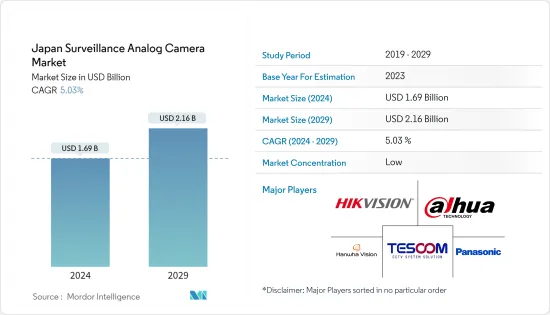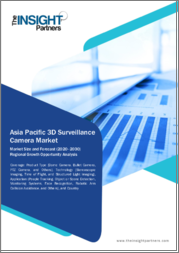
|
시장보고서
상품코드
1550355
일본의 감시용 아날로그 카메라 : 시장 점유율 분석, 산업 동향·통계, 성장 예측(2024-2029년)Japan Surveillance Analog Camera - Market Share Analysis, Industry Trends & Statistics, Growth Forecasts (2024 - 2029) |
||||||
일본의 감시 아날로그 카메라 시장 규모는 2024년에 16억 9,000만 달러로 추정되며, 2029년에는 21억 6,000만 달러에 달할 것으로 예측되며, 예측 기간 중(2024-2029년) CAGR 5.03%로 성장할 것으로 예측됩니다.

주요 하이라이트
- 아날로그 감시 카메라는 일반적으로 디지털 IP 기반 시스템보다 구매, 설치 및 정비에 있으며, 비용 효율적입니다. 이러한 비용 이점은 조직이 보안 요구 사항과 예산 제약의 균형을 맞추어야 하는 대규모 배포에서 중요합니다. 아날로그 카메라는 기존 아날로그 기반 영상 관리 시스템과 원활하게 통합할 수 있으므로 비용이 많이 드는 인프라 점검의 필요성을 줄일 수 있습니다.
- 일본의 기존 감시 시스템은 대부분 수십년전에 설치된 아날로그 카메라 기술을 기반으로 하고 있습니다. 이러한 레거시 시스템의 수명이 다함에 따라 적절한 보안 및 감시 기능을 유지하기 위해 시스템 교체 및 업그레이드의 필요성이 증가하고 있습니다. 아날로그 카메라는 기존 인프라와 쉽게 통합할 수 있고 직원 재교육이 최소화되어 친숙하고 신뢰할 수 있는 교체 옵션으로 간주되는 경우가 많습니다.
- 일본의 지역적 위치와 기후로 인해 일본의 인프라는 지진, 태풍, 폭설 등 다양한 자연재해에 노출되어 있습니다. 아날로그 카메라는 견고한 구조와 가혹한 환경 조건을 견딜 수 있는 능력으로 유명하며, 미션 크리티컬한 보안 용도에 적합한 선택이 되고 있습니다. 정전이나 네트워크 장애가 발생하더라도 아날로그 시스템의 안정적인 성능은 일본에서 아날로그 카메라의 채택을 촉진하는 중요한 요인으로 작용하고 있습니다.
- 그러나 이러한 카메라는 확장성에 문제가 있는 경우가 많으며, 카메라 수를 늘리거나 다른 시스템과 통합하는 것은 복잡하고 비용이 많이 듭니다. 아날로그 시스템과 디지털 시스템 간의 표준화된 프로토콜이나 상호운용성이 없기 때문에 원활한 통합을 더욱 복잡하게 만들고 아날로그 감시 네트워크의 유연성을 제한하고 있습니다.
- 일본의 지속적인 경제 성장과 급속한 도시화로 인해 인프라 투자가 활발해지고 있으며, 특히 감시 산업이 강화되고 있습니다. 이러한 보안 솔루션에 대한 수요가 아날로그 카메라를 포함한 감시 카메라 시장을 촉진하고 있습니다. 국제통화기금(IMF)은 일본의 GDP가 2023년 4조 2,129억 4,000만 달러에서 2029년 4조 9,447억 4,000만 달러로 증가할 것으로 전망하고 있습니다. 이러한 성장은 일본 경제의 호황에 힘입은 것으로, 조사 대상 시장에도 좋은 징조입니다.
일본의 감시 아날로그 카메라 시장 동향
아날로그 카메라의 비용 효율성이 시장 성장을 촉진할 것으로 전망
- 아날로그 카메라는 일반적으로 IP 기반 디지털 카메라에 비해 기본 가격이 저렴합니다. 이는 예산이 한정된 조직이나 여러 사이트에 대한 감시 범위를 확장하려는 조직에 큰 이점이 될 수 있습니다. 초기 투자가 적기 때문에 아날로그 카메라는 특히 중소기업과 공공 기관에 더 친숙합니다. 또한 일본 재무부의 발표에 따르면 2023년 일본 정부는 중소기업(SMB) 진흥을 위해 약 1,700억 엔(-12억 달러)의 초기 예산을 배정했습니다.
- 일본의 많은 운송 및 물류 회사들은 인프라에 깊숙이 내장된 아날로그 카메라에 많은 투자를 하고 있습니다. 이러한 아날로그 설정을 최신 IP 기반 솔루션으로 교체하는 것은 복잡하고 비용이 많이 듭니다. 아날로그 카메라는 대부분 기존 동축 케이블 기반 네트워크에 쉽게 통합할 수 있습니다. 기업은 새로운 이더넷 케이블이나 네트워크 스위치 설치와 같은 비용이 많이 드는 네트워크 인프라 업그레이드를 피할 수 있습니다. 아날로그 카메라는 설치 과정이 간단하므로 인건비와 프로젝트 기간을 줄일 수 있습니다.
- 아날로그 카메라는 내구성이 뛰어나고 움직이는 부품이 적기 때문에 정비 및 수리 빈도가 적습니다. 아날로그 시스템의 유지보수는 더 간단하고 비용 효율적이며 전문 기술자나 리소스가 필요하지 않습니다. 또한 아날로그 카메라는 전력 소비가 적기 때문에 조직의 에너지 지출을 줄일 수 있습니다.
- 아날로그 카메라의 비용 효율성으로 인해 모니터링 시스템을 단계적으로 업그레이드할 수 있습니다. 조직은 완전하고 값 비싼 정밀 검사를 선택하는 대신 현재 프레임 워크 내에서 아날로그 카메라를 체계적으로 통합하거나 교체 할 수 있습니다. 이러한 단계적 전략은 보다 관리하기 쉬운 자금 지출을 가능하게 하고 조직의 감시 역량을 강화할 수 있습니다.
운송 및 물류 최종사용자 산업이 큰 시장 점유율을 차지할 것으로 예상
- 일본의 교통 및 물류 네트워크는 고속도로, 철도, 항만, 공항, 창고, 물류센터 등 광범위하고 지역적으로 분산되어 있습니다. 동일본 여객철도(JR 동일본)의 2024년 여객 철도 운송 수입은 약 1조 6,800억 엔(-107억 달러)에 달하고, 2023년 대비 증가세를 보였습니다. 이 방대한 인프라를 모니터링하고 안전을 보장하기 위해서는 아날로그 카메라를 사용하여 비용 효율적으로 도입할 수 있는 대규모 모니터링 시스템이 필요합니다. 아날로그 카메라를 통해 조직은 전체 투자를 줄이면서 더 넓은 지역을 커버할 수 있습니다.
- 야외 보관소, 반입구, 야외 터미널 등 많은 운송 및 물류 시설은 가혹한 환경 조건에 노출되어 있습니다. 극한의 온도, 높은 습도, 먼지 등 전자 장비의 성능과 신뢰성에 악영향을 미치는 요인이 포함됩니다. 아날로그 카메라는 일반적으로 이러한 가혹한 환경 조건을 견딜 수 있고 내구성과 수명이 뛰어납니다.
- 일본의 일부 운송 및 물류 기업은 인프라에 깊숙이 내장된 아날로그 카메라에 많은 투자를 하고 있습니다. 이러한 아날로그 설정을 최신 IP 기반 솔루션으로 전환하는 것은 복잡하고 비용이 많이 듭니다. 일반적으로 네트워크의 대대적인 점검과 복잡한 시스템 통합이 필요합니다. 아날로그 카메라를 선택하면 보다 점진적이고 비용 효율적인 방법을 찾을 수 있습니다. 이 접근 방식은 현재 인프라와의 원활한 통합을 촉진하고 조직은 선행 투자를 최대한 활용할 수 있습니다.
- 운송 및 물류 부문은 비용 효율을 우선시하여 업무를 간소화하고 경쟁력을 유지하기 위해 노력하고 있습니다. 초기 비용이 낮은 아날로그 카메라는 예산에 민감한 이 업계의 조직에 어필할 수 있습니다. 또한 인프라 및 유지보수 비용 절감은 아날로그 카메라의 비용 효율성을 더욱 높여 운송 및 물류 업체들에게 매우 중요한 요소로 작용하고 있습니다.
일본의 감시용 아날로그 카메라 산업 개요
일본의 감시용 아날로그 카메라 시장은 매우 세분화되어 있으며, 로컬 기업과 세계 기업이 시장 패권을 놓고 경쟁하고 있습니다. 주요 기업은 경쟁력을 강화하기 위해 제휴, 합병 및 인수와 같은 전략적 움직임과 함께 혁신을 촉진하기 위해 연구개발에 자원을 투입하고 있습니다. 주목해야 할 시장 참여 기업에는 Hangzhou Hikvision Digital Technology, Dahua Technology, CP PLUS, Zhejiang Uniview Technologies, Shenzhen Sunell Technology Corporation 등이 있습니다.
- 2023년 10월, 하이크비전은 업계 최초로 F1.0 조리개를 갖춘 2MP 아날로그 카메라를 발표했습니다. 이 이정표는 ColorVu 고정형 터렛(DS-2CE70DF0T-MF) 및 발렛(DS-2CE10DF0T-F) 카메라의 출시와 함께 축하를 받았습니다. 이 카메라는 24시간 내내 뛰어난 풀 컬러 이미지를 제공하며, 편리한 업그레이드를 위해 아날로그 케이블로 HD를 지원합니다. 또한 3D 디지털 노이즈 감소(DNR) 기술 및 우수한 백색광 범위와 같은 고급 기능을 갖추고 있습니다.
- 2023년 7월, Dahua Technology는 HDCVI 2023을 출시하여 아날로그 기술 진화의 10년을 기념했습니다. HDCVI는 High Definition Composite Video Interface의 약자로 카메라와 XVR을 연결하는 하나의 동축 케이블로 오디오, 비디오, 데이터, 오디오, 비디오, 데이터, 전원 신호를 1,000미터까지 전송할 수 있으며, HDCVI 2023은 일련의 지능형 기능을 통해 별도의 설정 없이도 설치자와 최종사용자의 HD 모니터링을 간소화할 수 있는 HDCVI 2023을 통해 설치자와 최종사용자의 HD 모니터링을 간소화할 수 있도록 지원합니다.
기타 혜택 :
- 엑셀 형식의 시장 예측(ME) 시트
- 3개월간의 애널리스트 지원
목차
제1장 서론
- 조사의 전제조건과 시장 정의
- 조사 범위
제2장 조사 방법
제3장 개요
제4장 시장 인사이트
- 시장 개요
- 업계의 매력 - Porter's Five Forces 분석
- 신규 진출업체의 위협
- 바이어의 교섭력
- 공급 기업의 교섭력
- 대체품의 위협
- 경쟁 기업 간 경쟁 강도
- 업계 밸류체인 분석
- 시장의 거시경제 동향의 평가
제5장 시장 역학
- 시장 성장 촉진요인
- 아날로그 카메라의 비용 효율이 시장 성장을 촉진
- 시장 성장 억제요인
- 기술적 한계
제6장 시장 세분화
- 최종사용자 산업별
- 정부기관
- 은행
- 헬스케어
- 운송·물류
- 산업
- 기타(교육기관, 소매, 기업)
제7장 경쟁 구도
- 기업 개요
- Dahua Technology Co., Ltd.
- Hangzhou Hikvision Digital Technology Co., Ltd.
- Hanwha Vision Co., Ltd.
- TESCOM JAPAN CO.,Ltd.
- Panasonic Holdings Corporation
- CP PLUS
- Sony Corporation
- Pelco
- Tyco(Johnson Control Brand)
- SAMSUNG ELECTRONICS Co., Ltd.
제8장 투자 분석
제9장 시장의 미래
KSA 24.10.04The Japan Surveillance Analog Camera Market size is estimated at USD 1.69 billion in 2024, and is expected to reach USD 2.16 billion by 2029, growing at a CAGR of 5.03% during the forecast period (2024-2029).

Key Highlights
- Analog surveillance cameras are generally more cost-effective to purchase, install, and maintain than digital IP-based systems. This cost advantage is significant for large-scale deployments, where organizations must balance security requirements with budgetary constraints. Analog cameras can seamlessly integrate with existing analog-based video management systems, reducing the need for costly infrastructure overhauls.
- Many of Japan's existing surveillance systems were installed decades ago and are based on analog camera technologies. As these legacy systems reach the end of their lifespan, there is a significant need to replace and upgrade them to maintain adequate security and monitoring capabilities. Analog cameras are often seen as a familiar and reliable replacement option, as they can be easily integrated with the existing infrastructure and require minimal personnel retraining.
- Japan's geographical location and climate expose its infrastructure to various natural disasters, including earthquakes, typhoons, and heavy snowfall. Analog cameras are renowned for their rugged construction and ability to endure harsh environmental conditions, making them a preferred choice for mission-critical security applications. The reliable performance of analog systems, even during power outages or network disruptions, is a key factor driving their adoption in Japan.
- However, such cameras frequently encounter scalability challenges, making it complex and costly to expand the number of cameras or integrate them with other systems. The absence of standardized protocols and interoperability between analog and digital systems further complicates seamless integration, limiting the flexibility of analog surveillance networks.
- Japan's ongoing economic expansion and swift urbanization drive heightened infrastructure investments, notably in bolstering the surveillance industry. This persistent need for security solutions propels the surveillance camera market, encompassing analog cameras. The International Monetary Fund (IMF) projects Japan's GDP to rise from USD 4,212.94 billion in 2023 to USD 4,944.74 billion by 2029. This growth is bolstered by the nation's strong economy, which bodes well for the market studied.
Japan Surveillance Analog Camera Market Trends
Cost-Effectiveness of Analog Cameras is Expected to Drive the Market Growth
- Analog cameras typically have a lower base price than their digital IP-based counterparts. This can be a significant advantage for organizations with limited budgets or those looking to expand their surveillance coverage across multiple sites. The lower initial investment makes analog cameras more accessible, especially for small and medium-sized businesses or public-sector entities. In addition, as per the Ministry of Finance Japan, in fiscal year 2023, the Japanese national government allocated an initial budget of around JPY 170 billion (~USD 1.2 billion) for promoting small- and medium-sized businesses (SMBs).
- Analog cameras generally require less complex and less expensive infrastructure than IP-based systems. Analog cameras can often be easily integrated into existing coaxial cable-based networks, which are still widely used in Japan. Organizations can avoid costly network infrastructure upgrades, such as installing new Ethernet cabling or network switches. The more straightforward installation process for analog cameras reduces labor costs and project timelines.
- Analog cameras boast enhanced durability, with fewer moving parts, necessitating less frequent maintenance and repairs. Maintaining analog systems is simpler and more cost-effective, demanding fewer specialized technicians and resources. Moreover, analog cameras exhibit lower power consumption, translating to reduced energy expenditures for organizations.
- The cost efficiency of analog cameras empowers organizations to upgrade their surveillance setups gradually. Rather than opting for a complete and expensive overhaul, organizations can systematically integrate or replace analog cameras within their current framework. This phased strategy allows for a more manageable financial outlay, enabling organizations to bolster their surveillance capabilities.
Transportation and Logistics End-User Industry is Expected to Hold a Significant Market Share
- Japan's transportation and logistics network is extensive and geographically dispersed, encompassing highways, railways, ports, airports, warehouses, and distribution centers. East Japan Railways Company (JR East) also saw its revenue from passenger railway transportation in Japan reach around JPY 1.68 trillion (~USD 10.7 billion) in FY 2024, marking an increase from FY 2023. Monitoring and securing this vast infrastructure requires a large-scale surveillance system that can be cost-effectively deployed using analog cameras. Analog cameras enable organizations to cover a wider area with a lower overall investment.
- Many transportation and logistics facilities, such as outdoor storage yards, loading docks, and open-air terminals, are exposed to harsh environmental conditions. These include extreme temperatures, high humidity, dust, and other factors that can adversely impact the performance and reliability of electronic equipment. Analog cameras are generally more resilient and better equipped to withstand these challenging environmental conditions, offering superior durability and longevity.
- Several transportation and logistics firms in Japan have heavily invested in analog cameras deeply woven into their infrastructure. Swapping these analog setups for modern IP-based solutions proves intricate and expensive. It typically demands substantial network overhauls and intricate system integrations. Opting for analog cameras presents a more gradual, cost-efficient path. This approach facilitates seamless integration with the current infrastructure, allowing organizations to maximize their prior investments.
- The transportation and logistics sector prioritizes cost efficiency, striving to streamline operations and stay competitive. With lower initial costs, analog cameras appeal to budget-conscious organizations in this industry. Moreover, the decreased infrastructure and maintenance expenses further bolster the cost-effectiveness of analog cameras, a pivotal factor for transportation and logistics players.
Japan Surveillance Analog Camera Industry Overview
Japan's surveillance analog camera market is highly fragmented, with local and global players vying for market dominance. Major players channel resources into R&D to drive innovation alongside strategic moves such as partnerships, mergers, and acquisitions to bolster their competitive edge. Notable market participants include Hangzhou Hikvision Digital Technology Co. Ltd, Dahua Technology Co. Ltd, CP PLUS, Zhejiang Uniview Technologies Co. Ltd, and Shenzhen Sunell Technology Corporation.
- October 2023: Hikvision's move came with introducing the industry's first 2 MP analog cameras, featuring an impressive F1.0 aperture. This milestone was celebrated with the launch of their ColorVu Fixed Turret (DS-2CE70DF0T-MF) and Bullet (DS-2CE10DF0T-F) Cameras. These cameras offer superior full-color imaging round the clock and support HD over analog cabling for convenient upgrades. Additionally, they come equipped with advanced features like 3D Digital Noise Reduction (DNR) technology and an exceptional white light range.
- July 2023: Dahua Technology marked a decade of analog technology evolution with the release of HDCVI 2023. This latest iteration introduced global customers to AI-powered Over-Coax technology. HDCVI, short for High Definition Composite Video Interface, sets the standard for long-distance HD transmission, reaching up to 1,200 meters for audio, video, data, and power signals-all through a single coaxial cable connecting the camera and XVR. HDCVI 2023 elevates the game with a suite of intelligent functions, streamlining HD monitoring for installers and end-users without extra configurations.
Additional Benefits:
- The market estimate (ME) sheet in Excel format
- 3 months of analyst support
TABLE OF CONTENTS
1 INTRODUCTION
- 1.1 Study Assumptions and Market Definition
- 1.2 Scope of the Study
2 RESEARCH METHODOLOGY
3 EXECUTIVE SUMMARY
4 MARKET INSIGHTS
- 4.1 Market Overview
- 4.2 Industry Attractiveness - Porter's Five Forces Analysis
- 4.2.1 Threat of New Entrants
- 4.2.2 Bargaining Power of Buyers
- 4.2.3 Bargaining Power of Suppliers
- 4.2.4 Threat of Substitute Products
- 4.2.5 Intensity of Competitive Rivalry
- 4.3 Industry Value Chain Analysis
- 4.4 An Assessment of Macroeconomic Trends on the Market
5 MARKET DYNAMICS
- 5.1 Market Drivers
- 5.1.1 Cost-Effectiveness of Analog Cameras' Drives the Market Growth
- 5.2 Market Restraint
- 5.2.1 Technological Limitations
6 MARKET SEGMENTATION
- 6.1 By End-User Industry
- 6.1.1 Government
- 6.1.2 Banking
- 6.1.3 Healthcare
- 6.1.4 Transportation and Logistics
- 6.1.5 Industrial
- 6.1.6 Others (Education Institutions, Retail, and Enterprises)
7 COMPETITIVE LANDSCAPE
- 7.1 Company Profiles
- 7.1.1 Dahua Technology Co., Ltd.
- 7.1.2 Hangzhou Hikvision Digital Technology Co., Ltd.
- 7.1.3 Hanwha Vision Co., Ltd.
- 7.1.4 TESCOM JAPAN CO.,Ltd.
- 7.1.5 Panasonic Holdings Corporation
- 7.1.6 CP PLUS
- 7.1.7 Sony Corporation
- 7.1.8 Pelco
- 7.1.9 Tyco (Johnson Control Brand)
- 7.1.10 SAMSUNG ELECTRONICS Co., Ltd.















